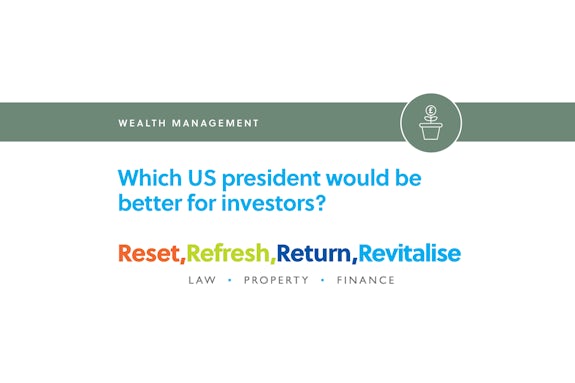
Victory for Joe Biden in November’s US election may not be bad news for equity markets
Global stock markets have just enjoyed their best August since 1986. In what is normally a quiet holiday month, markets were buoyed by hopes of further economic support from the US Federal Reserve, and by indications that major global economies are on a recovery path.
The US stock market has led the way, with the S&P 500 Index hitting an all-time high last month. But the latest surge has heightened concerns about the risks ahead and the gap between stock prices and the still-fragile global economic recovery.
The most immediate test for markets will be next week’s US central bank meeting and whether the Fed commits to more action and stimulus. The second test will be the US presidential election in November.
It’s a well-worn phrase that markets dislike uncertainty, and it seems that investors are bracing themselves for a turbulent couple of months. The futures market is forecasting increased volatility as expectations of a victory for Joe Biden, the Democratic candidate, have fallen dramatically over the past month. It’s now looking a much closer race to the White House.
What’s more, markets are also anticipating volatility extending beyond the election, reflecting fears of a delayed or disputed result; something that President Trump has already talked about.
But looking beyond the election result, what might a Biden victory mean for investors? Traditionally, investors take a bearish view of Democratic presidents, citing a greater likelihood of business-unfriendly policies, such as tax increases and regulation, which can harm corporate profitability.
However, further analysis suggests things are not so clear-cut. Since 1933, Democratic presidents have on average overseen higher stock market returns than Republican ones. For example, the average real (adjusted for inflation) total return for the S&P 500 Index under Democratic presidents was 10.2%, versus 6.9% under Republicans.

| Aug 19–Aug 20 | Aug 18–Aug 19 | Aug 17–Aug 18 | Aug 16–Aug 17 | Aug 15–Aug 16 | |
| S&P 500 Index | 10.2% | 9.1% | 17.9% | 17.4% | 31.2% |
Source: Financial Express; data shown for S&P500 Total Return index. Past performance is not a guide to future returns.
However, nearly all of this outperformance can be explained by the boom years under Bill Clinton and the subsequent dotcom bust and Global Financial Crisis under George W. Bush. Excluding these two presidencies, the difference in returns is practically zero.
Neither political party is exclusively good or bad for markets. Instead, what matters more is the policies presidents choose to enact and their net impact. For example, although Trump’s tax cuts were widely seen as a positive development for markets, his handling of foreign policy and trade issues had the opposite effect.
If the Democrats win control of Congress, US share prices are likely to price in a rise in corporate tax rates. Biden has said he would partially reverse Trump’s tax cuts early in 2021. Coupled with a proposed increase in the minimum wage, which would also hit corporate profits, this could boost the appeal of non-US equities. However, there is a high chance that corporate tax reform would take a back seat in Biden’s first year in office while economic rescue packages are prioritised.
Although tensions between the US and China are likely to persist under a Biden presidency, there may well be a thawing of international relations elsewhere. This would be a welcome relief for global markets after the volatile years of Trump’s presidency.
Foreign policy decision-making rests with the president, but if the Republicans hold onto the Senate then Biden’s tax reforms are unlikely to pass. It could be argued that a tax status quo and an improvement in international relations would be the best-case scenario for global stocks.
Such uncertainty underlines the need to retain a long-term perspective, and the importance of holding a portfolio that is diversified by asset class, country and sector. By doing so, investors will be in the best position to ride out any volatility, and exploit opportunities, created by November’s election.
Past performance is not a guide to future returns.
The value of an investment with St. James’s Place will be directly linked to the performance of the funds selected and the value may fall as well as rise. You may get back less than the amount invested.
© S&P Dow Jones LLC 20[20]. All rights reserved.
The information and opinions contained in this blog are for information only. They are not intended to constitute advice and should not be relied upon or considered as a replacement for advice. Before acting on any of the information contained in this blog, please seek specific advice from Gilson Gray Financial Management.







